
5 Exercise to strengthen lower back that Every Yoga Practitioner Needs
Hi there! I’m Dav Jones, excited to share my love for yoga and movement with you. Building a strong lower back has greatly impacted my practice and teaching. Welcome to a blog post that shares useful, applicable ways to strengthen and stretch the lower back region of the spine and musculature. In this blog, we’ll look at five simple Exercise to strengthen lower back postures that are featured in the traditional yoga asana practice and can help bring strength and mobility to the lumbar region of the spine, from which every movement practitioner can benefit. I’ll explain each posture, talk about its benefits, and give tips for staying safe. Whether you’re an experienced movement enthusiast or just starting your movement practices, this guide is here to help you get stronger and more stable. Let’s get started and build a stronger back together!
5 Exercise to strengthen lower back for Yoga & Movement Practitioners
1. Downward-Facing Dog
Downward-Facing Dog, also known as Adho Mukha Svanasana, is a foundational pose in yoga and serves as one of the Exercise to strengthen lower back. This pose affects the lower back region of the spine; it creates mobility in the lumbar vertebrae and stretches the quadratus lumborum muscles and erector spinae muscles that surround the lumbar region.
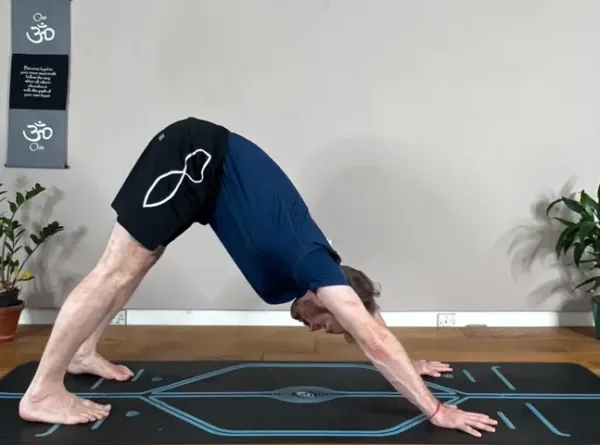
Application:
- Start in a ‘Child’s Pose’ with the arms extended forward. Palms pressing down.
- Curl your toes under and lift your hips up and back.
- First, start with a bend in the knees. Create an active foundation through the arms and upper body. Once you feel secure through the upper body, start to work on straightening the knees and pressing the heels toward your mat.
Tips:
- Press down through the first knuckle and the outer edge of your hands.
- Maintain a slight bend in your knees if your hamstrings and lower legs are tight.
- Focus on lengthening your spine rather than forcing your heels to the ground.
Benefits:
- Stretches the posterior chain of the body – hamstrings, calve, lower back.
- Strengthens the arms, shoulders, and legs.
- Improves circulation and relieves tension.
2. Ardha Uttanasana
Ardha Uttanasana or Half intense lift pose is a great way to shorten the lower back muscles and is one of the Exercise to strengthen lower back. This posture features regularly in the traditional Sun Salutation sequences. When teaching this I encourage practitioners to work towards finding a straight spine, and then slightly lift the thoracic region of the spine. This action opens the chest and shortens the lower back muscles. This is a great way to incorporate a way to shorten the muscle fibres in the lower back, a function that is often lacking in sedentary lifestyle postures – lots of sitting down.
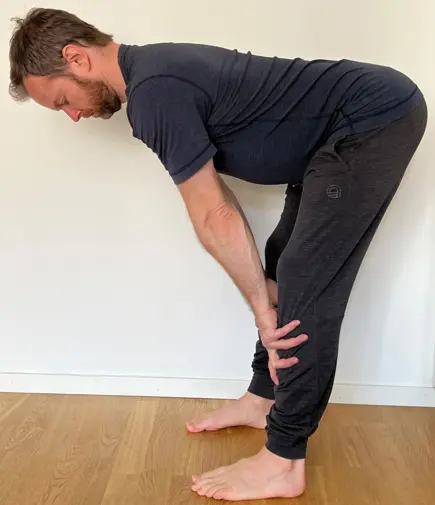
Application:
- From standing, raise your arms above your head and fold forward over your legs.
- Place your hands at the shins below the knees.
- Lift your chest and try to straighten your spine.
- Place one hand on your lower back to the side of the spine to where you feel muscle tissue. Do you feel muscle tone here? If not, lift your chest more and also tilt your tailbone up.
Tips:
- Keep your knees slightly bent to reduce load/stretch intensity on your hamstrings and lower legs.
- Play with anterior tilt of the pelvis to increase the contraction of the lower back muscles.
Benefits:
- Strengthens the lower back muscles and eccentrically loads the posterior legs.
- Improves hip flexibility and mobility.
- Enhances posterior chain endurance.
3. Locust Pose (Shalabhasana)
Locust Pose or Shalabhasana is a great posture to concentrically contract not only the lower back muscles but most of the muscles that are located at the back of the body. It is also one of the Exercise to strengthen lower back.
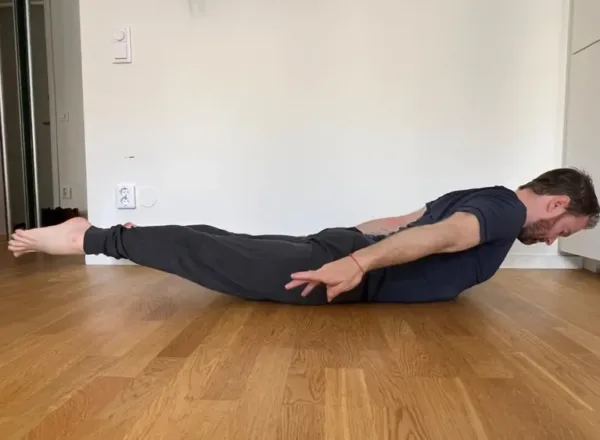
Application:
- Come onto the front of your body in a prone position. Feet slightly wider than the width of your
- Place your hands beside your hips.
- Take a breath in, and on your exhale simultaneously lift your chest, arms, and feet off the floor.
- Reach your fingers for your feet and draw your shoulder blades towards each other.
- Contract through your Glutes and try to lift your feet a little higher.
Tips:
- Directly inhale into the upper chest and collarbone region.
- On each exhale, gradually increase the contraction of the posterior muscles.
Benefits:
- Strengthens Upper and Lower back muscles.
- Strengthens Glute muscles.
- Builds lower back endurance.
4. Setu Bandhasana (Bridge Pose)
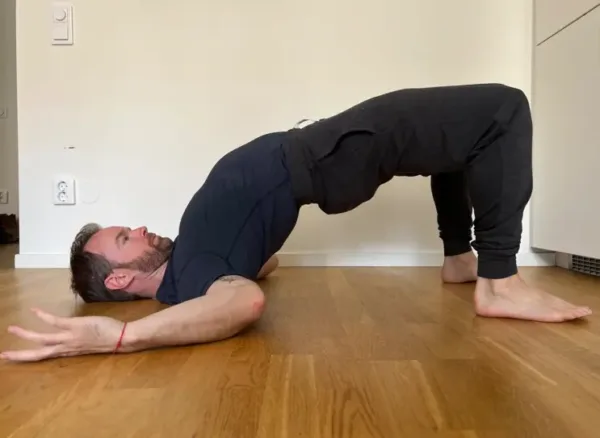
Application:
- Lie in a supine position on your mat. Bend your knees and place the soles of your feet about hip-width apart.
- Place your feet in a position so you can feel the mound of your big toe, little toe, and the heels of your feet.
- Place your arms by your hips.
- Breathe in, and on the exhale, lift your hips by pressing down through the points of contact through your feet.
Tips:
- Explore the position of your pelvis through anterior and posterior tilting. By exploring different positions, can either increase the contraction of the lower back muscles (anterior tilting) or bring space to the lumbar region (posterior tilting).
- Play with different foot positions. This can provide additional sensory nuance and change the muscle lengths in the muscles of the legs.
Benefits:
- Concentrically contracts the lower back muscles.
- Concentrically contracts the Glute max muscles.
- Increases spinal extension through the lumbar and thoracic regions of the spine.
5. Sukhasana Twist (Easy-Seated Twist)
The easy-seated twist is a lovely posture to lengthen and stretch the quadratus lumborum muscles of the lower back. These lower back muscles help to stabilise the lumbar region of the spine, along with helping to laterally flex the spinal column.
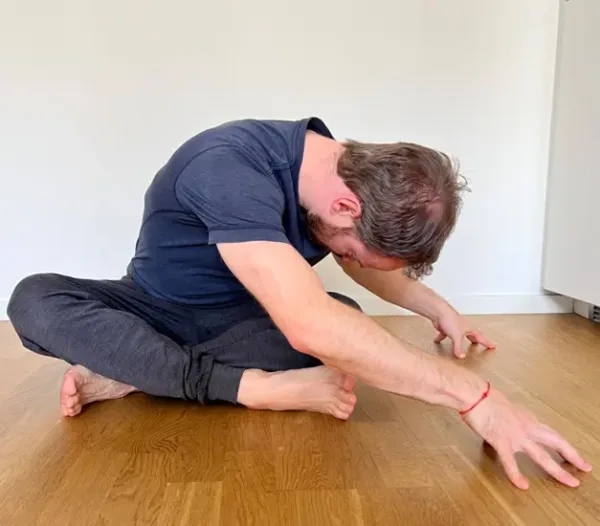
Application:
- Sit in a crossed-legged position on your mat.
- Cross the right leg in front of the left. Aim to position both feet under their respective knees.
- Rotate your body towards the right foot.
- Fold forward over the right foot, and left knee.
- You’ll feel a stretch in the left side of the lower back and potentially in the outer left hip.
- Spend 30–60 seconds (6/7 breaths) in the stretch, and then switch the legs and repeat on the other side.
Tips:
- Elevate your hips, so the top edge of the knees is roughly level with the hip points.
- Practice breathing calmly.
Benefits:
- Stretches the Quadratus Lumborum muscles of the lower back region.
- Opens up the muscles of the outer hips.
Common Movements to Complement Lower Back Exercises
Pairing your strengthening exercises with the right mobility movements is a great way to create an improved range through the spinal column. This can help provide increased blood flow along with circulating the lymphatic fluid. These movements not only aid in recovery but also improve your overall mobility, making your workouts more effective. Here are a few additional movements to consider:
The ‘Cat-Cow’ Movement
Great for spinal flexibility and mobility for the spine. This common movement pattern that features regularly in a yoga practice is a fantastic way to not only mobilise your spine but also provides movement to your shoulder blades and the pelvis.
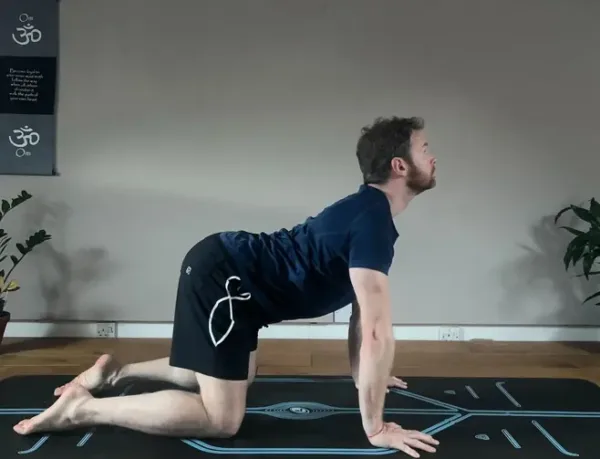
Application:
- Start on your hands and knees in a tabletop position.
- Inhale, arch your back, and lift your head (Cow Pose).
- Exhale, round your back, and tuck your chin (Cat Pose).
- Repeat for several breaths.
Benefits:
- Increases spinal mobility.
- Can help to relieve tension in the lower back.
Child’s Pose
Relieves lower back tension and promotes relaxation. This gentle stretch is perfect for unwinding after a workout or a long day. It’s also a great pose to incorporate into your daily routine to help reset and rejuvenate your mind and body. By flexing the spine and flexing the hips, Child’s Pose is also an opportunity to breathe into the back of the ribcage and respiratory diaphragm. By increasing the expansion in the back of the ribcage can also help to direct increased pressure in the lower back region which in turn can aid in stability of the lumbar regions of the spine.
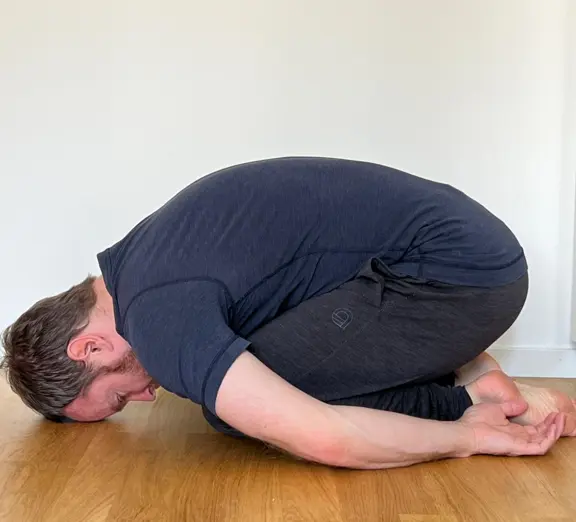
Application:
- Come into Hero’s pose, sitting on your shins and tops of your feet.
- Fold forward over your legs, resting your belly on your thighs and your forehead on the mat.
- Breathe into the middle of your back.
Benefits:
- It stretches the lower back muscles and the Erector Spinae muscles.
- Calms the mind and reduces stress.
Bhujangasana (Cobra Pose)
The Cobra posture is an excellent posture to increase lumbar extension for the lower back. This posture also helps in providing an opening to the chest region. This pose not only helps alleviate tension in your lower back but also strengthens your Gluteus Maximus muscles.
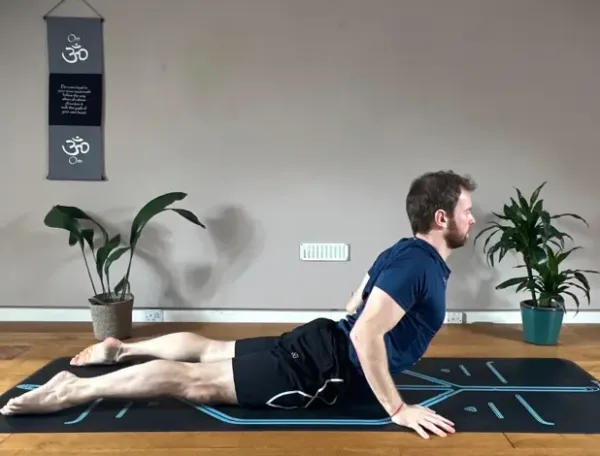
Application:
- Lie in a prone position (on the stomach) face down on the mat with your hands beside your chest.
- Contract your glutes, press down with your hands, and lift your chest off the ground while keeping the front of your hip bones in contact with the mat.
- Hold the position for a few breaths, then release.
Benefits:
- Mobilises the lumbar spine in extension.
- Opens up the chest and shoulders.
- Improves spinal flexibility.
Benefits of Exercise to strengthen lower back for Yogi and Movement Practitioners.
Strengthening your lower back is more than just preventing pain or injury; it has a multitude of benefits that can enhance your overall athletic performance and daily life. Here are some key advantages of Exercise to strengthen lower back:
1. Improved Posture
A strong lower back helps maintain lordosis in your lumbar spine. Keeping lordosis in the lower back is important in how your spine receives load bearing from the constant interaction with the Earth’s gravity. For movement enthusiasts, maintaining the natural spinal curves of the spine is vital for movement longevity and long-term spinal health.
Key Points:
- Supports natural spinal curves.
- Reduces slouching and rounded shoulders.
- Improves breathing efficiency and oxygen intake during activities.
2. Enhanced Athletic Performance
A robust lower back is crucial for many sports and physical activities. It provides the stability and power needed for jumping, running, and lifting. For movement practitioners, this means increased power and explosiveness, improved balance and coordination, and overall enhanced body strength, enabling peak performance in various movement disciplines.
Key Points:
- Increases power and explosiveness.
- Improves balance and coordination.
- Supports overall body strength.
- Essential for agility and endurance.
3. Reduced Risk of Injury
Strengthening your lower back can protect you from injuries, especially during heavy lifting or high-impact sports. A strong back can better absorb shocks and handle stress. Athletes, in particular, benefit from a lower risk of lower back strains, sprains, and other injuries, allowing for safer and more effective training sessions.
Key Points:
- Prevents lower back strains and sprains.
- Supports safe movement mechanics.
- Reduces the likelihood of overuse injuries.
- Enhances resilience against sudden impacts and twists.
4. Better Core Stability
Your lower back is an integral part of your core. Strengthening it improves overall core stability, which is essential for virtually every movement. For athletes, a stable core translates to enhanced balance, efficient movement, and prevention of compensatory injuries in other areas, supporting a solid foundation for all athletic activities.
Key Points:
- Enhances balance and stability.
- Supports efficient movement.
- Prevents compensatory injuries in other areas.
- Critical for maintaining form and technique in sports.
5. Increased Flexibility and Mobility
Strong lower back muscles contribute to better flexibility and mobility through the spinal column, making everyday movements with increased range and control. Athletes gain a wider range of motion, reduced stiffness, and improved performance in stretching exercises, which are crucial for maintaining agility and fluidity in their movements.
Key Points:
- Facilitates a wider range of motion.
- Reduces stiffness and tightness.
- Enhances performance in stretching exercises.
- Improves overall athletic agility and fluidity.
Safety & Precaution
Safety is paramount when working on your lower back to prevent injuries and ensure effective training. Here are some essential safety tips and precautions to keep in mind when engaging in Exercise to strengthen lower back:
- Warm-Up: Always start with a proper warm-up to prepare your muscles and joints for exercise.
- Proper Form: Maintain correct form and technique to avoid straining your lower back. Consider working with a trainer if you’re unsure about your form.
- Listen to Your Body: Respect your body’s limitations and train to a capacity that is manageable to your current fitness level.
Final Thought
If you’re eager to deepen your yoga practice, Exercise to strengthen lower back, join the Dav Jones Yoga online classes available on Patreon. You’ll find a variety of sessions tailored to different skill levels, ensuring there’s something for everyone. Additionally, the DJY mentorship program offers personalised guidance to help you refine your practice and understand the profound benefits of yoga. These online resources are designed to support your growth, whether you’re just beginning or looking to advance your yoga or movement practice. Embrace the journey and transform your yoga practice with Dav Jones Yoga.



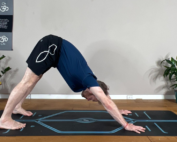

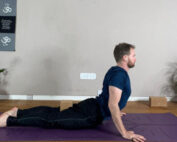
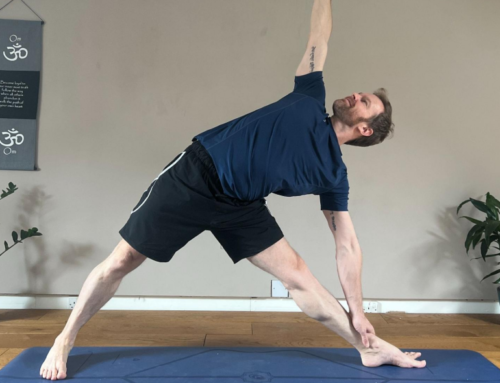
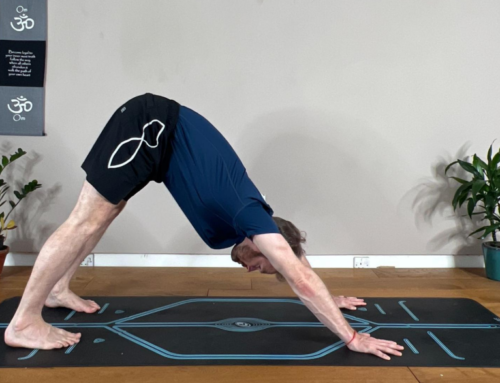
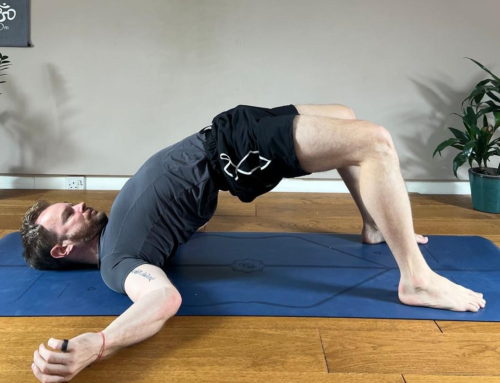

[…] start with foundational practices to build strength and flexibility. Focus on forearm balance and backbend exercises. Use props, like a wall or yoga blocks, for support and safety. Practice regularly, but listen to […]